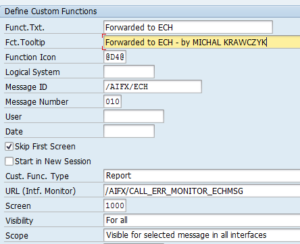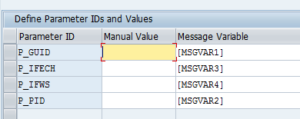Michal’s Tips: ECH monitoring for Enterprise Services in AIF
ECH monitoring for Enterprise Services in AIF
Most of the SAP delivered Enterprise Services use the Error and Conflict Handler (ECH) to handle messages which end up with errors. AIF seems to be integrated with ECH but there are many ways to enable this integration. We can either turn off ECH to monitor ECH completely in AIF (ECH will not be used at all) or we can make AIF use ECH error status messages. The second approach is much better in cases where the SAP delivered Enterprise Service used some other ECH functionalities which would stop working if ECH is completely turned off. The only difficulty is that you need two AIF interfaces to monitor a single interface:
– one for monitoring ECH messages
– one for monitoring successful proxies
Let me demonstrate the idea of using the AIF for the second case.
Prerequisite
OSS note 2094472 : Support of standard enterprise services.
Step 1
As per OSS note you need to define two AIF interfaces for the same inbound proxy class: one for ECH and one for Proxy. The main difference will be the Interface engine configuration where for proxy interface you can use the default values but for ECH you need to use ECH for all engines:
– Application Engine = ECH
– Persistence Engine = ECH
– Selection Engine = ECH
– Logging Engine = ECH
Step 2
In step 2 you need to assign the correct ECH component to the ECH AIF interface – Interface Development -> Additional Interface Properties -> Assign ECH Component
Step 3
You also need to perform all of the manual steps from the OSS note:
– create the implementation for two enhancement spots /AIF/ERROR_HANDLING and /AIF/ENGINES
– perform the manual post customizing which includes creating a custom function. This function will allow you to navigate between the AIF message of the proxy interface to the same AIF message in the ECH interface. This way you can not only work with specific functions of two monitors but also drill down to both of them (to proxy monitor from proxy interface and to ECH monitor from the ECH interface). You can find the information on how to create the custom function on the screenshots below.
Figure 1 – Custom function for ECH monitoring
Figure 2 – Parameters for custom function for ECH monitoring
How does it work
Now when you try to monitor your message AIF you only need to open the proxy version of your interface as it will always contain both types of messages (correctly processed and incorrectly processed). For the ones which failed you will see a status message saying that the error is in ECH and by using the arror you can drill down to the ECH version of the AIF interface from where you can perform all ECH related activities.
Figure 3 – ECH drilldown from AIF Proxy interface
References:
You can find some more info on ECH, proxy monitoring and AIF in my book : SAP SOA Integration – Enterprise Service Monitoring.
Special thanks:
Verena Woerner for helping me with customizing of this functionality.
Michał Krawczyk – SAP integration consultant since 2004. He has been recognized by SAP included becoming an SAP Mentor in 2007 and winning the top contributor/topic leader award from SDN (SAP Developer Network portal) in SAP PO/PI eight times. Michal is the author many SAP integration related books.
Popular tags
ABAP int4 INT4 IFTT Int4Interview S/4HANA SAP AIF SAP CPI sap integration





